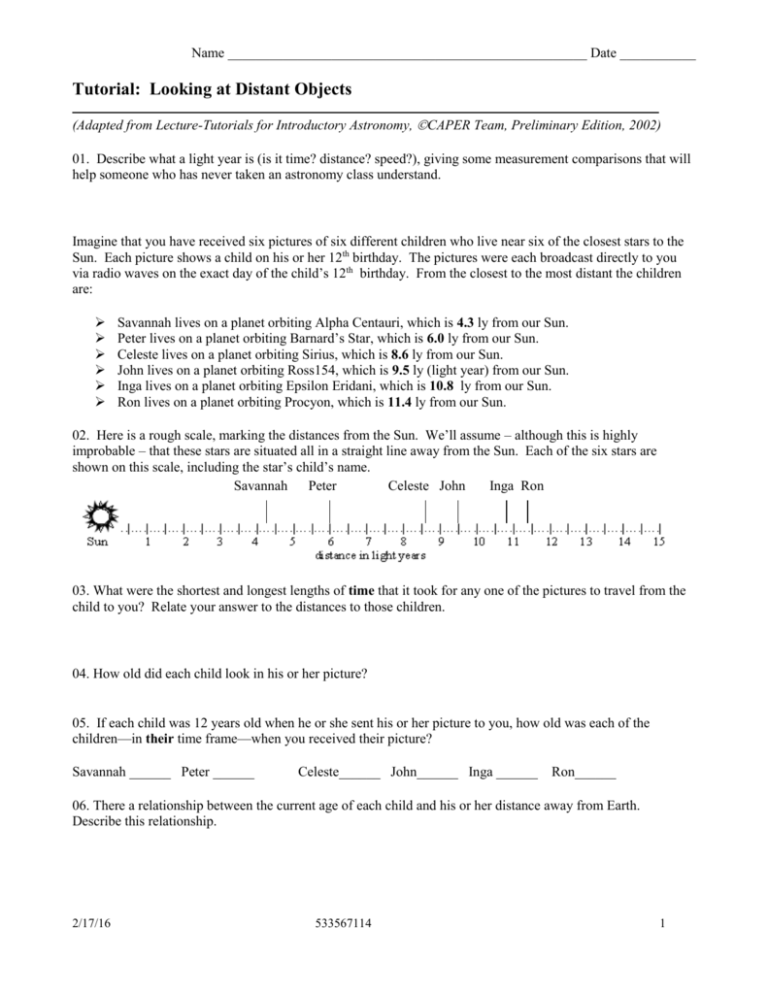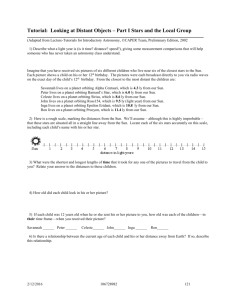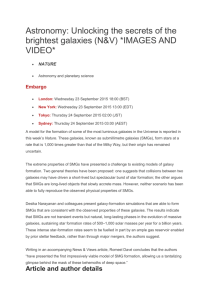Tutorial: Looking at Distant Objects
advertisement

Name ____________________________________________________ Date ___________ Tutorial: Looking at Distant Objects (Adapted from Lecture-Tutorials for Introductory Astronomy, CAPER Team, Preliminary Edition, 2002) 01. Describe what a light year is (is it time? distance? speed?), giving some measurement comparisons that will help someone who has never taken an astronomy class understand. Imagine that you have received six pictures of six different children who live near six of the closest stars to the Sun. Each picture shows a child on his or her 12th birthday. The pictures were each broadcast directly to you via radio waves on the exact day of the child’s 12th birthday. From the closest to the most distant the children are: Savannah lives on a planet orbiting Alpha Centauri, which is 4.3 ly from our Sun. Peter lives on a planet orbiting Barnard’s Star, which is 6.0 ly from our Sun. Celeste lives on a planet orbiting Sirius, which is 8.6 ly from our Sun. John lives on a planet orbiting Ross154, which is 9.5 ly (light year) from our Sun. Inga lives on a planet orbiting Epsilon Eridani, which is 10.8 ly from our Sun. Ron lives on a planet orbiting Procyon, which is 11.4 ly from our Sun. 02. Here is a rough scale, marking the distances from the Sun. We’ll assume – although this is highly improbable – that these stars are situated all in a straight line away from the Sun. Each of the six stars are shown on this scale, including the star’s child’s name. Savannah Peter Celeste John Inga Ron 03. What were the shortest and longest lengths of time that it took for any one of the pictures to travel from the child to you? Relate your answer to the distances to those children. 04. How old did each child look in his or her picture? 05. If each child was 12 years old when he or she sent his or her picture to you, how old was each of the children—in their time frame—when you received their picture? Savannah ______ Peter ______ Celeste______ John______ Inga ______ Ron______ 06. There a relationship between the current age of each child and his or her distance away from Earth. Describe this relationship. 2/17/16 533567114 1 07. Let’s change the circumstances a bit. Imagine that the six pictures were broadcast by satellite to you from those planets and that they all arrived at exactly the same time. For this to be true, does that mean that all of the children sent their pictures at the same time? Explain your answer. 08. We can think of a way for these pictures to arrive all at the same time. The child that is the farthest away sends his or her picture first. The next farthest child waits until he or she receives that picture, and then sends his or her picture right away. This continues as signals travel to Earth. Figure out how much time passes between each child before he or she receives the pictures from those children farther away, and mark the times on the distance scale above. 09. a. How old do each of these individuals look in the pictures that we receive? Ron _____ Inga _____ John _____ Celeste _____ Peter _____ Savannah _____ b. How old are they all really (at their locations)? _______ yrs 10. Although they are many thousands of light-years away, the Andromeda galaxy and the Magellanic Clouds are actually quite close to us, compared to the many other galaxies in the Universe. Astronomers can routinely detect galaxies that are as far as 11 billion light-years away! Although we are just detecting the light from these galaxies now, how many years ago was the light from these galaxies emitted? 11. Assuming that the Universe is 14 billion years old and galaxies formed only a few hundred million years after the Big Band, what is the maximum possible age of the distant galaxies in question 10 as we detect them in these images? Explain your reasoning. QuickT i me™ and a decom pressor are needed t o see thi s pi cture. 2 QuickT i me™ and a decom pressor are needed t o see thi s pi cture. QuickT i me™ and a decom pressor are needed t o see thi s pi cture. QuickTime™ and a decompressor are needed to see this picture. 12. Shown below are 4 galaxies with redshifts of approximately 3.5, 2.5, 1.5, and 0.1. Using the appearances of these galaxies in these images, explain how we use the concept of look-back time to understand the evolution of galaxies with time.









